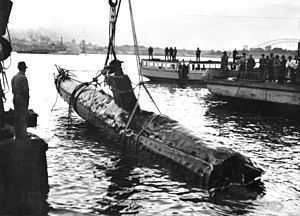| Attack on Sydney Harbour | |||||||
|---|---|---|---|---|---|---|---|
| Part of the Axis naval activity in Australian waters during World War II | |||||||
 A Japanese Ko-hyoteki class midget submarine, believed to be midget No. 14, is raised from Sydney Harbour the day after the attack. | |||||||
| |||||||
| Belligerents | |||||||
|
|
| ||||||
| Commanders and leaders | |||||||
| Gerard Muirhead-Gould | Hankyu Sasaki | ||||||
| Strength | |||||||
|
2 heavy cruisers, 1 light cruiser, 2 armed merchant cruisers, 2 destroyers, 3 corvettes, 1 submarine, 2 anti-submarine vessels, 6 channel patrol boats |
5 fleet submarines, 3 midget submarines, 2 seaplanes | ||||||
| Casualties and losses | |||||||
|
1 depot ship sunk, 21 killed, 10 wounded[1] |
2 midget submarines sunk, 1 midget submarine scuttled, 2 spotter planes lost, 6 killed | ||||||
| Secondary operations saw 3 Allied merchant vessels sunk, and 50 personnel killed (including a pilot who crashed his aircraft while responding to an attack), with no Japanese losses | |||||||
From 31 May to 8 June 1942, during World War II, Imperial Japanese Navy submarines made a series of attacks on the Australian cities of Sydney and Newcastle. On the night of 31 May – 1 June, three Ko-hyoteki-class midget submarines, (M-14, M-21 and M-24) each with a two-member crew, entered Sydney Harbour, avoided the partially constructed Sydney Harbour anti-submarine boom net, and attempted to sink Allied warships. Two of the midget submarines were detected and attacked before they could engage any Allied vessels. The crew of M-14 scuttled their submarine, whilst M-21 was successfully attacked and sunk. The crew of M-21 killed themselves. These submarines were later recovered by the Allies. The third submarine attempted to torpedo the heavy cruiser USS Chicago, but instead sank the converted ferry HMAS Kuttabul, killing 21 sailors. This midget submarine's fate was unknown until 2006, when amateur scuba divers discovered the wreck off Sydney's northern beaches.
Immediately following the raid, the five Japanese fleet submarines that carried the midget submarines to Australia embarked on a campaign to disrupt merchant shipping in eastern Australian waters. Over the next month, the submarines attacked at least seven merchant vessels, sinking three ships and killing 50 sailors. During this period, between midnight and 02:30 on 8 June, two of the submarines bombarded the ports of Sydney and Newcastle.
The midget submarine attacks and subsequent bombardments are among the best-known examples of Axis naval activity in Australian waters during World War II, and are the only occasion in history when either city has come under attack. The physical effects were slight: the Japanese had intended to destroy several major warships, but sank only an unarmed depot ship and failed to damage any significant targets during the bombardments. The main impact was psychological; creating popular fear of an impending Japanese invasion and forcing the Australian military to upgrade defences, including the commencement of convoy operations to protect merchant shipping.
- ^ Nichols, Robert (31 May 2002). "Sydney Under Attack: Japanese Midget Submarine 31 May – 1 June 1942". Remembering 1942. Australian War Memorial. Retrieved 9 February 2014.